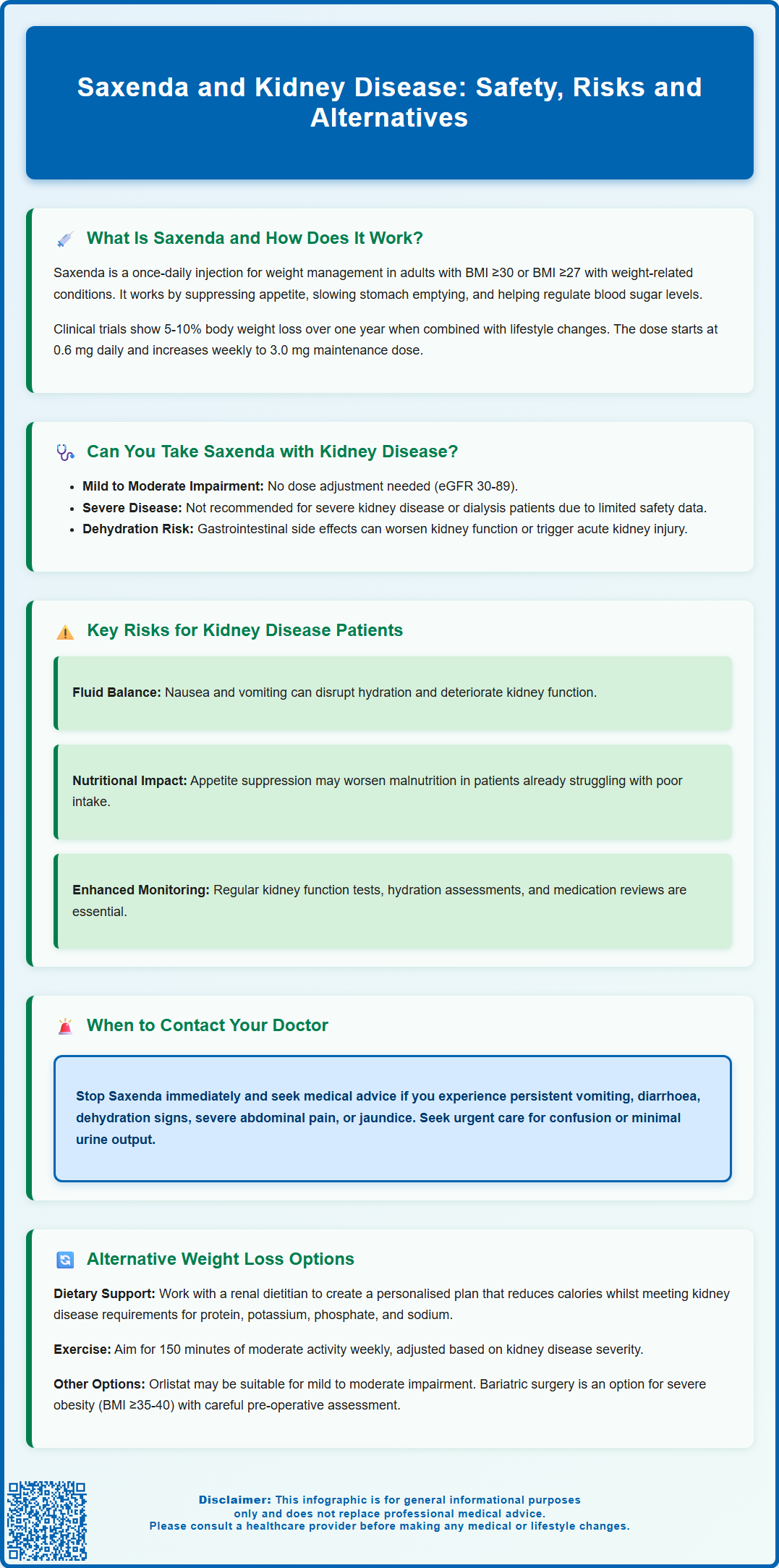Mounjaro®
Dual-agonist support that helps curb appetite, hunger, and cravings to drive substantial, sustained weight loss.
- ~22.5% average body weight loss
- Significant weight reduction
- Improves blood sugar levels
- Clinically proven weight loss

Saxenda (liraglutide 3.0 mg) is a glucagon-like peptide-1 (GLP-1) receptor agonist licensed in the UK for weight management in adults with obesity or overweight with comorbidities. For patients with kidney disease, using Saxenda requires careful medical assessment. Whilst no dose adjustment is needed for mild to moderate renal impairment, Saxenda is not recommended in severe kidney disease or end-stage renal failure due to limited clinical data and increased risk of dehydration-related complications. This article examines the safety considerations, monitoring requirements, and alternative weight management options for people with kidney disease.
Summary: Saxenda requires no dose adjustment in mild to moderate kidney disease but is not recommended in severe renal impairment or end-stage renal disease due to limited data and dehydration risks.
Saxenda (liraglutide 3.0 mg) is a prescription medicine licensed in the UK for weight management in adults with obesity (BMI ≥30 kg/m²) or overweight (BMI ≥27 kg/m²) with at least one weight-related comorbidity, such as type 2 diabetes, hypertension, or dyslipidaemia. It is also licensed for adolescents aged 12 to <18 years with body weight >60 kg. Saxenda is administered as a once-daily subcutaneous injection and should be used alongside a reduced-calorie diet and increased physical activity.
Treatment begins with a dose of 0.6 mg once daily, which is increased weekly by 0.6 mg until reaching the maintenance dose of 3.0 mg daily. In adults, treatment should be discontinued after 12 weeks at the 3.0 mg dose if weight loss of at least 5% of initial body weight has not been achieved.
Saxenda belongs to a class of medications called glucagon-like peptide-1 (GLP-1) receptor agonists. It works by mimicking the action of GLP-1, a naturally occurring hormone that regulates appetite and food intake. The mechanism of action involves several pathways:
Appetite suppression: Liraglutide acts on receptors in the brain (particularly in the hypothalamus) to reduce hunger and increase feelings of fullness after eating.
Delayed gastric emptying: It slows the rate at which food leaves the stomach, prolonging satiety and reducing the urge to eat between meals.
Improved glucose regulation: Although Saxenda is primarily used for weight loss rather than diabetes management, it can help regulate blood sugar levels by enhancing insulin secretion when glucose levels are elevated.
Clinical trials have demonstrated that Saxenda, when combined with lifestyle modifications, can lead to significant weight loss—typically 5-10% of initial body weight over one year. However, individual responses vary, and the medication is not suitable for everyone.
Common side effects include nausea, diarrhoea, constipation, and vomiting, particularly during the initial dose-escalation phase. More serious adverse effects can include pancreatitis (severe abdominal pain radiating to the back), gallbladder disease (right upper quadrant pain, jaundice), and increased heart rate. People with diabetes taking sulfonylureas or insulin may experience hypoglycaemia and may need dose adjustments of these medications.
Saxenda is not recommended during pregnancy or breastfeeding. Patients should be monitored regularly by their healthcare provider to assess efficacy and tolerability. Suspected side effects should be reported via the MHRA Yellow Card scheme (yellowcard.mhra.gov.uk).
The use of Saxenda in patients with kidney disease requires careful consideration and medical assessment. According to the Summary of Product Characteristics (SmPC) approved by the MHRA, no dose adjustment is required for patients with mild or moderate renal impairment (estimated glomerular filtration rate [eGFR] 30-89 mL/min/1.73m²). However, clinical experience in patients with severe renal impairment (eGFR 15-29 mL/min/1.73m²) or end-stage renal disease (eGFR <15 mL/min/1.73m² or requiring dialysis) is limited, and Saxenda is not recommended in these populations.
The primary concern relates to the potential for gastrointestinal side effects—particularly nausea, vomiting, and diarrhoea—which are common with GLP-1 receptor agonists. In patients with compromised kidney function, these adverse effects can lead to:
Dehydration and volume depletion: Reduced fluid intake combined with fluid losses can worsen kidney function.
Acute kidney injury (AKI): There have been post-marketing reports of acute renal failure and worsening of chronic renal failure in patients taking liraglutide, often associated with dehydration.
Electrolyte imbalances: Vomiting and diarrhoea can disturb sodium, potassium, and other electrolyte levels, which may be particularly problematic in kidney disease.
Before starting Saxenda, patients with any degree of kidney impairment should undergo thorough assessment, including recent renal function tests (serum creatinine, eGFR). Your GP or specialist will evaluate whether the potential benefits outweigh the risks in your individual case. If Saxenda is prescribed, close monitoring of renal function and hydration status is essential, particularly during the initial weeks of treatment when gastrointestinal side effects are most common.
If you experience persistent vomiting, diarrhoea, or signs of dehydration (such as dizziness, reduced urination, or dark urine) while taking Saxenda, you should temporarily stop the medication and contact your healthcare provider promptly. In cases of severe dehydration, inability to keep fluids down, markedly reduced urine output, or confusion, seek urgent medical advice via NHS 111 or emergency services as appropriate.

Kidney disease can significantly influence both the safety and effectiveness of Saxenda treatment. Understanding these interactions is crucial for patients and healthcare professionals managing weight loss in the context of renal impairment.
Pharmacokinetics and drug clearance: Liraglutide is primarily metabolised by proteolytic enzymes rather than being eliminated unchanged by the kidneys. Consequently, mild to moderate renal impairment does not substantially alter liraglutide exposure or clearance. However, in severe kidney disease, the overall metabolic capacity may be reduced, and there is limited data on how this affects drug handling in the body.
Increased risk of adverse effects: Patients with kidney disease may be more vulnerable to the gastrointestinal side effects of Saxenda. Key considerations include:
Fluid balance: Chronic kidney disease often involves careful fluid management. Nausea and vomiting can make it difficult to maintain adequate hydration, potentially precipitating acute deterioration in kidney function.
Medication burden: Many patients with kidney disease take multiple medications, increasing the risk of drug interactions and cumulative side effects.
Nutritional status: Kidney disease can affect appetite and nutritional intake. The appetite-suppressing effects of Saxenda may exacerbate malnutrition or protein-energy wasting in some patients.
Monitoring requirements: If Saxenda is prescribed to someone with kidney disease, enhanced monitoring is essential:
Regular renal function tests (at baseline, after initial weeks of treatment, then as clinically indicated)
Assessment of hydration status and fluid balance
Monitoring for signs of acute kidney injury (reduced urine output, swelling, fatigue)
Heart rate monitoring, particularly in patients with cardiovascular disease
Blood glucose monitoring in patients with diabetes, with review of concomitant diabetes medications
Review of concurrent medications that may affect kidney function (NSAIDs, ACE inhibitors, diuretics)
Patients should be advised to contact their GP immediately if they experience persistent vomiting, diarrhoea, or signs of dehydration, as prompt intervention may prevent serious complications. They should also seek urgent medical attention for severe abdominal pain (which may indicate pancreatitis) or right upper quadrant pain/jaundice (possible gallbladder disease). In some cases, temporary discontinuation of Saxenda may be necessary until symptoms resolve and kidney function stabilises.
For patients with kidney disease who cannot safely use Saxenda, or for whom it is not recommended, several alternative approaches to weight management are available. A multidisciplinary approach involving GPs, nephrologists, dietitians, and specialist weight management services is often most effective.
Lifestyle modifications remain the cornerstone of weight management in kidney disease:
Dietary intervention: A renal dietitian can develop an individualised eating plan that balances calorie reduction with the specific nutritional requirements of kidney disease (appropriate protein, potassium, phosphate, and sodium intake). The focus is typically on nutrient-dense, lower-calorie foods whilst avoiding excessive restriction that could worsen nutritional status.
Physical activity: Regular exercise, tailored to individual capabilities and comorbidities, can support weight loss and improve cardiovascular health. The UK Chief Medical Officers recommend at least 150 minutes of moderate-intensity activity per week for adults, though this may need modification in advanced kidney disease.
Alternative pharmacological options: Other weight loss medications may be considered, depending on kidney function and individual circumstances:
Orlistat: This lipase inhibitor reduces fat absorption and is licensed for weight management in the UK. It does not require dose adjustment in mild to moderate renal impairment, though there is limited data in severe kidney disease. Gastrointestinal side effects are common. Rarely, orlistat can cause oxalate nephropathy and kidney stones, so caution is advised in patients with existing kidney disease.
Semaglutide (Wegovy): Another GLP-1 receptor agonist, similar to Saxenda but with once-weekly dosing. According to the UK SmPC, no dose adjustment is required in renal impairment, though there is limited experience in severe renal impairment and end-stage renal disease. As with Saxenda, caution is needed due to the risk of dehydration and worsening kidney function.
Naltrexone/bupropion (Mysimba): This combination therapy has renal dosing restrictions and is contraindicated in end-stage renal failure.
Bariatric surgery: For patients with severe obesity and kidney disease, surgical options such as gastric bypass or sleeve gastrectomy may be considered. According to NICE guidance (CG189), bariatric surgery is generally considered for people with a BMI ≥40 kg/m², or between 35-40 kg/m² with significant comorbidities that could improve with weight loss. These procedures can achieve substantial weight loss and may even improve kidney function in some cases. However, careful pre-operative assessment is essential, as kidney disease increases surgical risk.
Specialist weight management programmes: NHS-funded tier 3 weight management services provide intensive, multidisciplinary support including behavioural therapy, nutritional counselling, and psychological support. These programmes can be particularly valuable for patients with complex medical needs.
Patients with kidney disease considering any weight loss intervention should discuss options thoroughly with their healthcare team to ensure the chosen approach is safe, appropriate, and aligned with their overall kidney disease management plan.
Saxenda requires no dose adjustment in mild to moderate renal impairment (eGFR 30–89 mL/min/1.73m²), but patients need close monitoring for dehydration and gastrointestinal side effects that could worsen kidney function.
There is limited clinical experience in severe renal impairment or end-stage renal disease, and the gastrointestinal side effects of Saxenda can cause dehydration and acute kidney injury in vulnerable patients.
Temporarily stop Saxenda and contact your GP or healthcare provider promptly, as persistent vomiting or diarrhoea can lead to dehydration and worsening kidney function requiring urgent medical assessment.
The health-related content published on this site is based on credible scientific sources and is periodically reviewed to ensure accuracy and relevance. Although we aim to reflect the most current medical knowledge, the material is meant for general education and awareness only.
The information on this site is not a substitute for professional medical advice. For any health concerns, please speak with a qualified medical professional. By using this information, you acknowledge responsibility for any decisions made and understand we are not liable for any consequences that may result.
Lorem ipsum dolor sit amet, consectetur adipiscing elit, sed do eiusmod tempor incididunt ut labore et dolore magna aliqua. Ut enim ad minim veniam, quis nostrud exercitation ullamco laboris nisi ut aliquip ex ea commodo consequat. Duis aute irure dolor in reprehenderit in voluptate velit esse cillum dolore eu fugiat nulla pariatur.
Block quote
Ordered list
Unordered list
Bold text
Emphasis
Superscript
Subscript